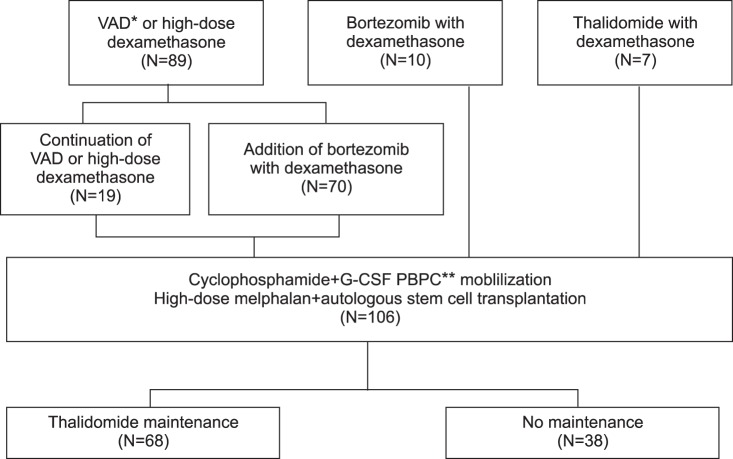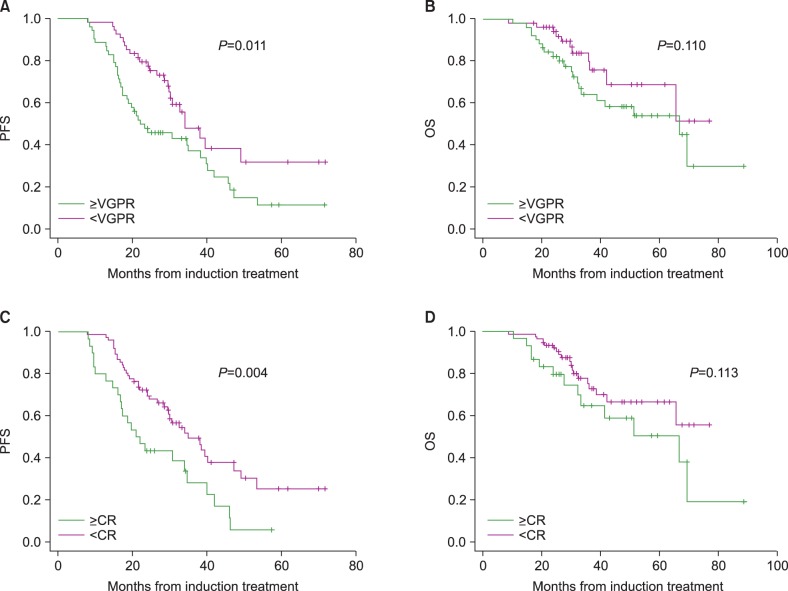Blood Res.
2013 Sep;48(3):198-205. 10.5045/br.2013.48.3.198.
The impact of novel therapeutic agents before and after frontline autologous stem cell transplantation in patients with multiple myeloma
- Affiliations
-
- 1Hematology, Department of Internal Medicine, Seoul St. Mary's Hospital, The Catholic University of Korea College of Medicine, Seoul, Korea. ckmin@catholic.ac.kr
- KMID: 2270706
- DOI: http://doi.org/10.5045/br.2013.48.3.198
Abstract
- BACKGROUND
Novel agents (NAs) such as thalidomide and bortezomib have been administered in combination with autologous stem-cell transplantation (ASCT) to effectively treat multiple myeloma (MM). However, whether NAs perform better as induction treatments prior to transplantation, or as post-transplant maintenance therapies remains unclear.
METHODS
We retrospectively analyzed 106 consecutive patients with MM who underwent ASCT within 1 year of diagnosis as first-line therapy.
RESULTS
Eighty-seven (82.1%) patients received NAs before ASCT, whereas 68 (64.2%) received NAs after ASCT. NAs were administered to each patient as follows: before ASCT alone (N=29, 27.4%), after ASCT alone (N=10, 9.4%) or both before and after ASCT (N=58, 54.7%). High-quality rates before and after ASCT were significantly higher for patients who received NAs as induction treatment compared to those who did not receive pre-transplant NAs. At a median follow-up of 37.9 months, the 3-year progression-free survival (PFS) and overall survival (OS) rates were 42.8% and 70.2%, respectively. The PFS and OS were significantly higher in patients with NAs as post-transplant maintenance treatment (P=0.03 and P=0.04, respectively), but not in those with NAs as pre-transplant induction treatment. The PFS of patients with NAs before and after ASCT was higher than that of the patients with NAs as induction therapy alone (P=0.05). Age, serum beta2-microglobulin level, complete response after ASCT, and NA use post-ASCT independently predicted survival outcomes.
CONCLUSION
These findings suggest that integration of NAs post-ASCT could benefit patients with MM undergoing ASCT. Induction therapy using NAs also improves high-quality response rates before and after ASCT.
Keyword
MeSH Terms
Figure
Reference
-
1. Laubach JP, Mahindra A, Mitsiades CS, et al. The use of novel agents in the treatment of relapsed and refractory multiple myeloma. Leukemia. 2009; 23:2222–2232. PMID: 19741729.
Article2. van de Donk NW, Lokhorst HM, Dimopoulos M, et al. Treatment of relapsed and refractory multiple myeloma in the era of novel agents. Cancer Treat Rev. 2011; 37:266–283. PMID: 20863623.
Article3. Reece DE. Posttransplantation maintenance therapy and optimal frontline therapy in myeloma. Hematology Am Soc Hematol Educ Program. 2011; 2011:197–204. PMID: 22160034.
Article4. Durie BG, Harousseau JL, Miguel JS, et al. International uniform response criteria for multiple myeloma. Leukemia. 2006; 20:1467–1473. PMID: 16855634.
Article5. Rajkumar SV, Harousseau JL, Durie B, et al. Consensus recommendations for the uniform reporting of clinical trials: report of the International Myeloma Workshop Consensus Panel 1. Blood. 2011; 117:4691–4695. PMID: 21292775.
Article6. Eom KS, Min CK, Lee S, et al. Efficacy of up-front treatment with a double stem cell transplantation in multiple myeloma. Jpn J Clin Oncol. 2006; 36:432–438. PMID: 16782727.
Article7. Min CK, Lee MJ, Eom KS, et al. Bortezomib in combination with conventional chemotherapeutic agents for multiple myeloma compared with bortezomib alone. Jpn J Clin Oncol. 2007; 37:961–968. PMID: 18156171.
Article8. Barlogie B, Smith L, Alexanian R. Effective treatment of advanced multiple myeloma refractory to alkylating agents. N Engl J Med. 1984; 310:1353–1356. PMID: 6546971.
Article9. Feyler S, Rawstron A, Jackson G, Snowden JA, Cocks K, Johnson RJ. Thalidomide maintenance following high-dose therapy in multiple myeloma: a UK myeloma forum phase 2 study. Br J Haematol. 2007; 139:429–433. PMID: 17910633.
Article10. Kaplan EL, Meier P. Nonparametric estimation from incomplete observations. J Am Stat Assoc. 1958; 53:457–481.
Article11. Cox DR. Regression models and life-tables. J R Stat Soc Series B Stat Methodol. 1972; 34:187–220.
Article12. Lahuerta JJ, Mateos MV, Martinez-Lopez J, et al. Influence of pre- and post-transplantation responses on outcome of patients with multiple myeloma: sequential improvement of response and achievement of complete response are associated with longer survival. J Clin Oncol. 2008; 26:5775–5782. PMID: 19001321.13. Kim JS, Kim K, Cheong JW, et al. Complete remission status before autologous stem cell transplantation is an important prognostic factor in patients with multiple myeloma undergoing upfront single autologous transplantation. Biol Blood Marrow Transplant. 2009; 15:463–470. PMID: 19285634.
Article14. Kumar SK, Dingli D, Dispenzieri A, et al. Impact of pretransplant therapy in patients with newly diagnosed myeloma undergoing autologous SCT. Bone Marrow Transplant. 2008; 41:1013–1019. PMID: 18332915.
Article15. Rabin N, Percy L, Khan I, Quinn J, D'Sa S, Yong KL. Improved response with post-ASCT consolidation by low dose thalidomide, cyclophosphamide and dexamethasone as first line treatment for multiple myeloma. Br J Haematol. 2012; 158:499–505. PMID: 22712536.
Article16. Attal M, Lauwers-Cances V, Marit G, et al. Lenalidomide maintenance after stem-cell transplantation for multiple myeloma. N Engl J Med. 2012; 366:1782–1791. PMID: 22571202.
Article17. Neben K, Lokhorst HM, Jauch A, et al. Administration of bortezomib before and after autologous stem cell transplantation improves outcome in multiple myeloma patients with deletion 17p. Blood. 2012; 119:940–948. PMID: 22160383.
Article18. Giralt S. Stem cell transplantation for multiple myeloma: current and future status. Hematology Am Soc Hematol Educ Program. 2011; 2011:191–196. PMID: 22160033.
Article19. Gertz MA, Kumar S, Lacy MQ, et al. Stem cell transplantation in multiple myeloma: impact of response failure with thalidomide or lenalidomide induction. Blood. 2010; 115:2348–2353. quiz 2560. PMID: 20089967.
Article20. Harousseau JL, Attal M, Avet-Loiseau H, et al. Bortezomib plus dexamethasone is superior to vincristine plus doxorubicin plus dexamethasone as induction treatment prior to autologous stem-cell transplantation in newly diagnosed multiple myeloma: results of the IFM 2005-01 phase III trial. J Clin Oncol. 2010; 28:4621–4629. PMID: 20823406.
Article21. Lokhorst HM, van der Holt B, Zweegman S, et al. A randomized phase 3 study on the effect of thalidomide combined with adriamycin, dexamethasone, and high-dose melphalan, followed by thalidomide maintenance in patients with multiple myeloma. Blood. 2010; 115:1113–1120. PMID: 19880501.
Article22. Wang L, Ran X, Wang B, Sheng Z, Liu L. Novel agents-based regimens as induction treatment prior to autologous stem-cell transplantation in newly diagnosed multiple myeloma: a meta-analysis of randomized controlled trials. Hematol Oncol. 2012; 30:57–61. PMID: 21809367.
Article23. Cavo M, Rajkumar SV, Palumbo A, et al. International Myeloma Working Group consensus approach to the treatment of multiple myeloma patients who are candidates for autologous stem cell transplantation. Blood. 2011; 117:6063–6073. PMID: 21447828.
Article24. Attal M, Harousseau JL, Leyvraz S, et al. Maintenance therapy with thalidomide improves survival in patients with multiple myeloma. Blood. 2006; 108:3289–3294. PMID: 16873668.
Article25. Spencer A, Prince HM, Roberts AW, et al. Consolidation therapy with low-dose thalidomide and prednisolone prolongs the survival of multiple myeloma patients undergoing a single autologous stem-cell transplantation procedure. J Clin Oncol. 2009; 27:1788–1793. PMID: 19273705.
Article
- Full Text Links
- Actions
-
Cited
- CITED
-
- Close
- Share
- Similar articles
-
- Emergence of chronic myeloid leukemia following autologous stem cell transplantation in a young woman with multiple myeloma
- A Case of Cerebral Toxoplasmosis Following Tandem Autologous Stem Cell Transplantation in a Multiple Myeloma Patient
- Diagnosis and therapy of multiple myeloma
- Successful Chemotherapy Following Autologous Stem Cell Transplantation in Multiple Myeloma and Multi-organ Dysfunction with Infiltration of Eosinophils: A Case Report
- HBV reactivation in a HBsAg-negative patient with multiple myeloma treated with prednisolone maintenance therapy after autologous HSCT





